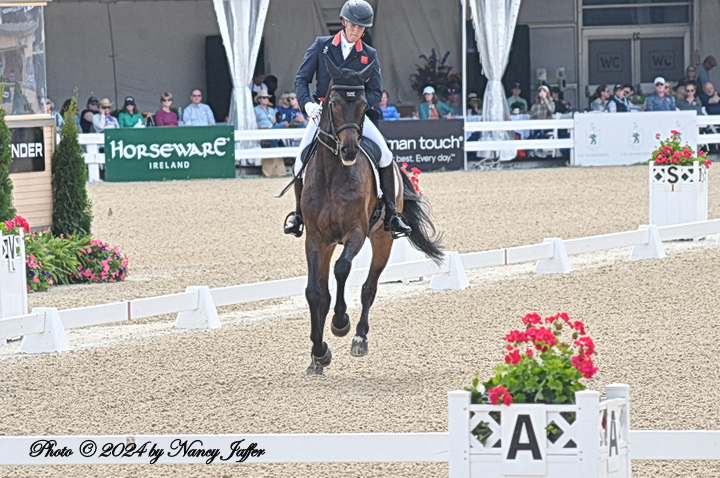
by Nancy Jaffer | Apr 26, 2024
Brits, Brits everywhere at the top of the leaderboard in both the 4-star Short and 5-star three-day events at the Kentucky Horse Park, where the dressage phase wrapped up on Friday.
In the Defender 5-star, a lovely, fluid test from Tom McEwen and JL Dublin was marked at 24.6 penalties, overtaking another British rider, World Champion Yasmin Ingham with Banzai du Loir, who led on 26 penalties after the first day of competition. That made the British contingent 1-2 in the featured division.
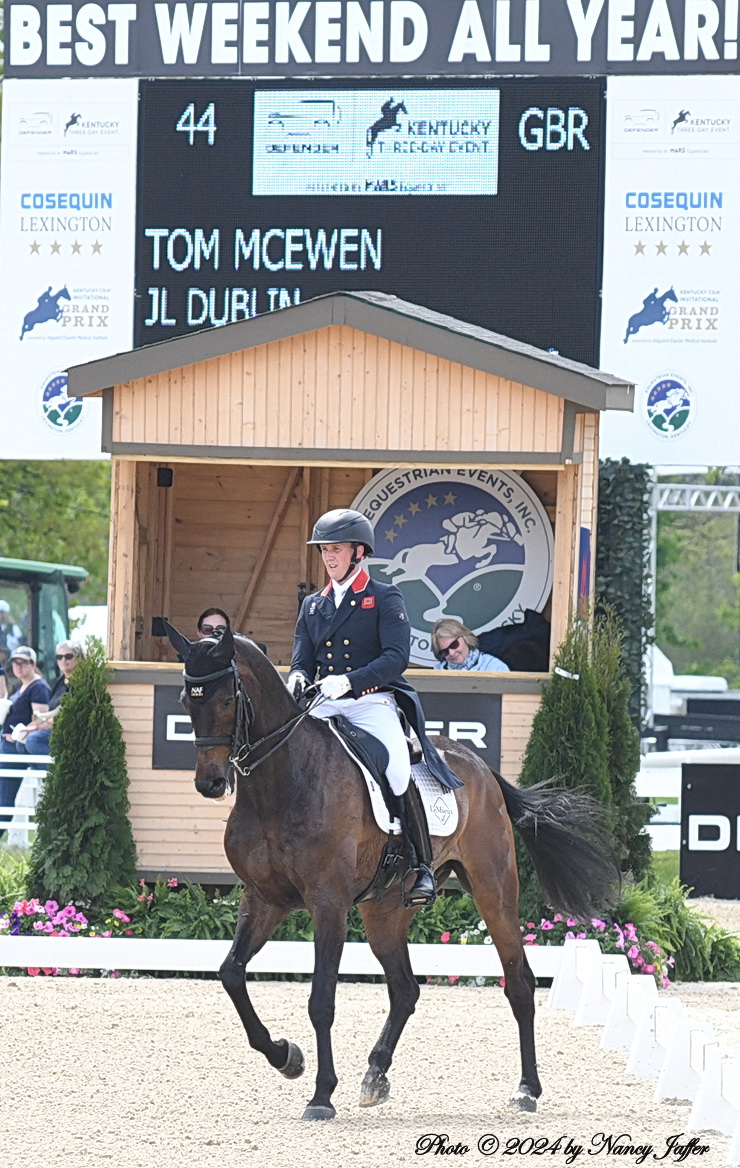
Tom McEwen and JL Dublin. (Photo © 2024 by Nancy Jaffer)
There is a tie at the top of the Cosequin Lexington 4-star between the USA’s Liz Halliday on Miks Master C, who was third in the Kentucky 5-star last year, and U.S.-based British rider Lucienne Bellissimo on DYRI (yes, she’s the wife of Mark Bellissimo, a Wellington, Fla., developer who is used to making headlines of his own). Both women were marked at 26 penalties.
But the Brit one might expect to be at the head of the 5-star rankings instead stands equal eighth. That’s three-time Kentucky winner and world number one Oliver Townend with the promising Cooley Rosalent, who started out with a mistake—going from the halt into the canter instead of the trot—which didn’t endear her to the judges, one would guess. Oliver is tied with 22-year-old German soldier Calvin Bockmann on The Phantom of the Opera with 31.4 penalties.
Analyzing his test, Oliver said, “I thought the exceptional bits were very good, and the mistakes were the mistakes.
“I felt the good bits weren’t rewarded really and the mistakes were whacked obviously, which is correct. But when you sit there and watch it and see late changes being awarded 7’s and 7.5’s, I think something needs to happen.” Then he hastily added, “That isn’t any sort of description to do with my test.”
He noted the fans (15,127 came to the park today) “were very noisy when we went in and then it went very quiet and then someone dropped a tin or something in (during) the walk, It did feel like things were unfolding against us. At the same time,” he said of his nine-year-old mare, “she’ll come on from that experience and it’s definitely not going to be a dressage competition.”
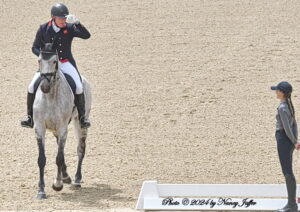
Oliver Townend tips his hat to the pony clubber managing the entrance to the arena. (Photo © 2024 by Nancy Jaffer)
As he always does, Tom gave credit for much of “Dubs’” training to the 13-year-old gelding’s former rider, Nicola Wilson, who was badly injured in a fall and passed the ride on to him. Tom inherited the horse and added his own touches to what is a formidable package.
“For sure it’s all down to Nicola; she’s done all the work for me,” he said. “I’m really lucky and fortunate to have a 5-star horse after all the hard work and training has been put in, and I get to play and tinker around with the movements to get the scores. But it takes hours of work no one ever sees so you can perform on a stage like this.”
He was second at Kentucky last year to Tamie Smith and Mai Baum, who became the first American winners since 2008. Mai Baum was going to compete in the 4-star at Kentucky in preparation for the Olympic selection process, but he was injured and remained in California. Tamie said he’s getting better and she will assess him after she heads home next week.
In the 4-star, Lucienne said she was “absolutely thrilled” with her horse, who she characterized as “one of those geldings who is a little bit introverted. Every time I go up the center line, he just loses a little bit of his confidence. And today was the first time he really started to let me in. He finished in a confident fashion, so that was fantastic.”
Lucienne, who also stands thirty-first with Tremanton, said, “I very much hope to be back here for the 5 star next year with the same two horses.”
A problem with his final lead change brought down the score for Miks Master C, known as Mickey, but Elisabeth said he “remembers the 5-star, and he is keen and ready to go, but he’s so professional now and a horse with so much power. He was a bit excitable today, so I just tried to keep him calm in the warmup.”
In the 5-star, Elisabeth and Cooley Nutcracker share the status of being the highest-placed American so far with Lauren Nicholson and the veteran Vermiculus. They each are third on 30.6 penalties.
While the Irish sporthorse Cooley Nutcracker is only 10 years old, Vermiculus, a fiery Anglo-Arab, has been there, done that at age 17. He first competed in the Kentucky 5-star as a 10-year-old.
When Lauren heard her score, she said, “I was shocked at where we were,” but noted some of the brilliant horses left the door open when they had a few not-so-brilliant moments.
The fact that Vermiculus did so well after a layoff last year made me wonder if Lauren, an Olympic veteran, is considering trying for the Paris Games this summer.
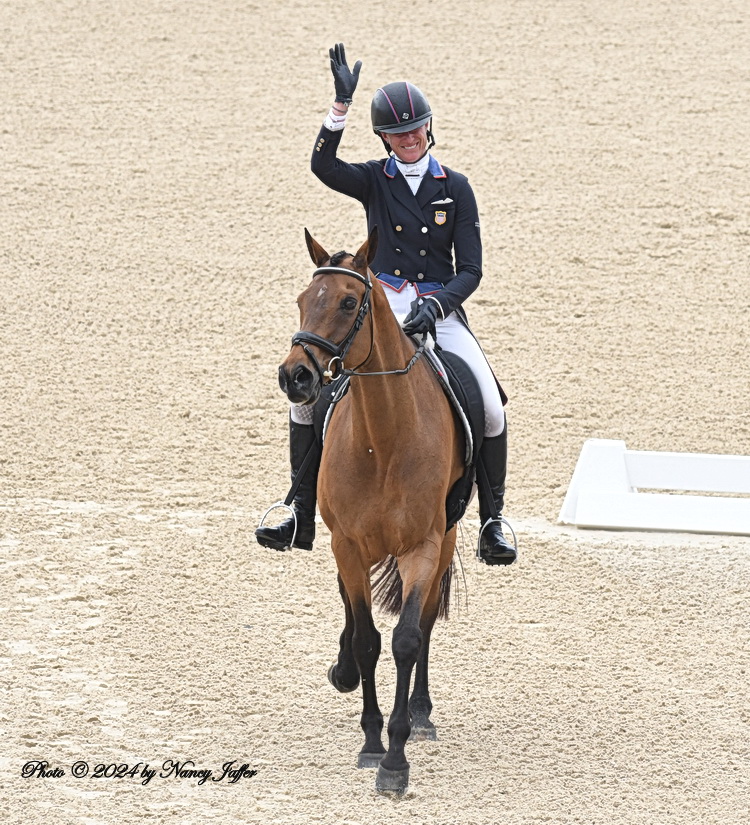
Lauren Nicholson and Vermiculus. (Photo © 2024 by Nancy Jaffer)
“I’ve thought about the Olympics every day of my life since I was six years old,” she revealed, adding she’d be lying if she said it didn’t cross her mind daily.
“There’s a point in your career when you are obsessed to get there, and then there’s a point in your career where you only want to go there if you’re going to be competitive. Making sure all the boxes are ticked and…I’m being as competitive as possible in preparing myself and my horse. I’m not interested in going just to get the accolade. I want to go to win medals for the U.S.”
But at the moment, we’re thinking more about Saturday’s cross-country than Paris
Toward that end, the clever folks at Equiratings are offering insight about the 5-star and who might win. Here’s what they point out:
This is one of the strongest Kentucky 5* fields since 2015, since it includes the current World Champion and a European Champion, as well as the world number one..
- Oliver Townend is making his hundredth five-star start. His first was in 2004 at Burghley. (30 x Burghley, 23 x Badminton, 17 x Luhmühlen, 10 x Kentucky 3 Day, 10 x Pau, 3 x Maryland, 3 x World Championships, 2 x Bicton, 1 x Olympics). A seven-time 5-star winner is partnered with last year’s Blenheim young horse winner, Cooley Rosalent.
- Since 2010, there have been seven British winners at Kentucky
- 25 Kentucky titles have been claimed (1998 to 2023) by riders from five different nations. The score from the two most prolific nations is currently Great Britain 8 – USA 7
- The reigning World Champions Yasmin Ingham and Banzai du Loir won CHIO Aachen in 2023. They have placed top 5 in 13 of their last 18 CCI4* runs. Prediction center gives Yasmin and Banzai a 25 percent win chance and 49 percent chance of a podium finish
- Tom McEwen entered this competition off the back of winning Kronenburg 4-star Short in March. Prediction center rates him with a 31 percnt chance of a win and 52 percent chance of podium finish at Kentucky
- Boyd Martin and On Cue – A two time 5* winning rider partnered with his Maryland 5* winning horse
- Every winner since 2010 has come from the top 5 after Dressage
- Seven out of the winners since 2010 have finished on their Dressage score
- Every Kentucky 5-star winner since 2010 has been in the top five after the first phase
- 11 of the last 13 cross-country leaders have gone on to win
- Quantum Leap (Doug Payne) – going for 4 from 4 perfect jumping clears
- Looking at statistics – only nine of the 43 starters will jump clear
- 11 of the last 13 cross country winners have gone on to win on Sunday
For the 4-star results click here
For the 5-star results, click here
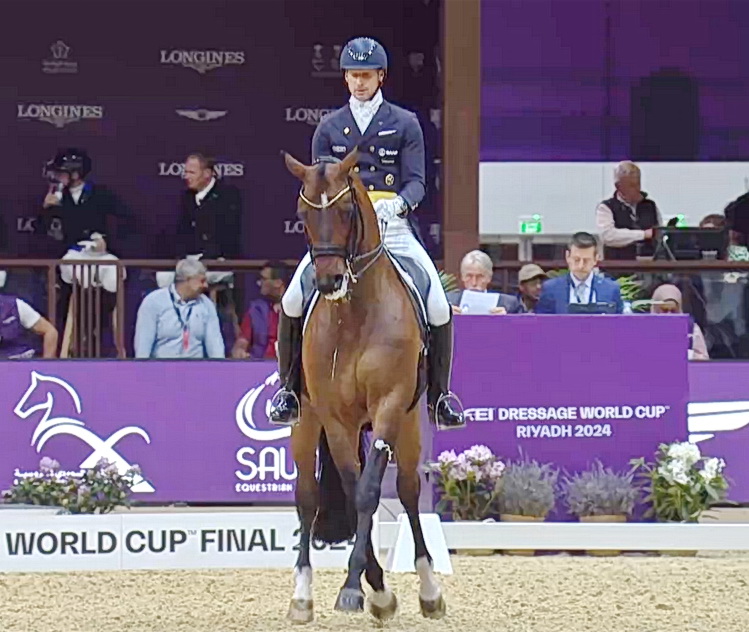
by Nancy Jaffer | Apr 19, 2024
Sweden, which is dominating the Longines Show Jumping World Cup Finals, got a winner in the co-featured dressage competition today, as Patrik Kittel took the prize on Touchdown during his ninth career start in the indoor championship.

Patrik Kittel and his trophy. (Photo FEI/Martin Dokoupil)
The show in Riyadh, Saudi Arabia, marred by the death of a show jumper on Thursday night (read about it here), had another mishap this afternoon; upsetting, though certainly far less serious. World Champion Lottie Fry of Great Britain, who won the Grand Prix on Wednesday, was not able to compete after her horse, Everdale, showed blood in his mouth before he started his performance.
The FEI stated: A minor bleed originating from the front gum mucosa was found in the mouth of the horse by the Judge at C, and in accordance with Article 430.7.6 of the FEI Dressage Rules, this results in elimination.
Elimination under this rule does not imply there was any wrongdoing but the rules are in place to protect the welfare of all competing horses.
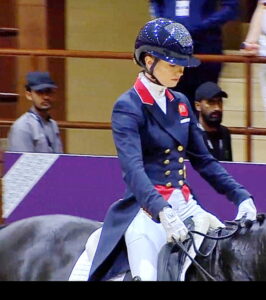
A downcast Lottie Fry leaves the arena after Everdale was eliminated.
Van Olst Horses, for whom Lottie rides, commented: “We are of course upset with the elimination, but the horse’s welfare always comes first and foremost so completely respect the decision. Everdale was checked over by the FEI vet team straight away and they couldn’t find any sign of a cut or abrasion in the mouth and our own vet has also given him a thorough check with no obvious cause.
“The most important thing is he’s fine and there is no injury. We were really happy with the warm up where he was relaxed, we took his bandages off and gave him a final check before heading in to the arena and can only think he maybe just caught his front lip as we went around the arena. It’s a disappointing way to end our FEI World Cup campaign but we have a happy horse to take home for another day.”
The freestyle had loads of atmosphere, with spectators — many in traditional Saudi dress — enjoying the music and cheering for each competitor.
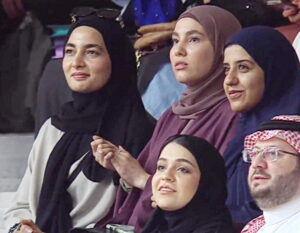
Saudi spectators watched the dressage intently.
The standard of performance was high, with everyone who made the podium marked at more than 81 percent in an incredibly close finish separated by fractions.
Patrik was in tears after his ride to James Bond movie theme music when he realized that he had won with a score of 81.661.
A close second was Denmark’s Nanna Skodborg Merrald (who also was second at last year’s finals in Omaha), with 81.429 percent on Blue Hors Don Olymbrio. Isabell Werth of Germany missed her sixth Cup victory, finishing third with DSP Quantaz (81.404)
An emotional Patrik said, “I cannot believe it. My horse was so amazing. Touchdown just flew with me. I was nervous. He felt amazing on the warmup and to go in there and perform like that. The crowd was unbelievable. Louise (Nathhorst) my trainer won it the first time for Sweden and now I won for Sweden again.
“I’m very overwhelmed. I’m not often overwhelmed but today I’m on another planet. The power and fighting spirit Touchdown shows me, it’s for me the biggest win. I cannot thank him enough.”
After her ride to the music of “Spiderman,” Nanna said, “It’s unbelievable finishing second one more year. I’m still almost shaking. He felt so great in there.
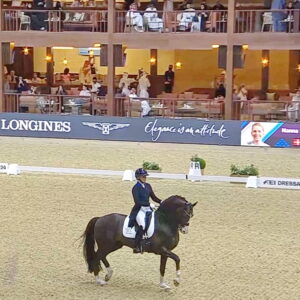
Nanna Skodborg Merrald and Blue Hors Don Olymbrio show their best in the atmospheric arena.
“I’m thrilled being able to be second between those two super riders. It was such a cool atmosphere in there today. I really liked riding my new music.”
Isabell originally was supposed to ride Emilio on his farewell tour before retirement, but he wasn’t sound enough to come so she brought Quantaz.
“It was very exciting,” she commented, noting there had never been such a narrow margin among the riders on the podium.
Quantaz faced a real challenge.
“Today it was very hard for him,” she said.
“When I came in, he was scared about the advertising, the screens. Also the people with the white clothes (men wearing the white flowing floor-length garment known as the thobe.)
“It was hard for him to concentrate. He was really with me and tried his best.It was a little bit busy with the atmosphere, but he really tried.”
You had to love her pirouettes appropriately timed to her music, which was “Turn Around.”
Although she has won the Finals five times, and participated on many more occasions, riding in them never gets boring for her.
“That’s what I love to do,” she said, citing. “so much energy and emotions. This is fun.”

Isabell Werth was pleased with her ride on DSP Quantaz.
Justina Vanagaite of Lithuania was eighth on Nabab with a score of 75.104. She was overcome with emotion after her ride, explaining she made the horse herself and she continues to be the one who does everything with the Belgian warmblood gelding. Unlike the people she was competing against, she doesn’t have a multi-person support staff.
“I’m the groom, I’m the trainer,” she said.

Justina Vanagaite and Nabab
Justina wore a blue and yellow ribbon showing her support for Ukraine. It has special meaning because Lithuania is one of the Baltic states that some believe are next on the Russian hit list.
The top finisher of the three American competitors was Anna Marek with Fayvel, ninth of 14 starters on 74.518 percent.
Though she won bronze individually at the Pan American Games last fall with another horse, this was Anna’s first Cup finals and she loved it.
“It’s so relaxing when you are able to concentrate on one horse and to be able to come to something like this, a World Cup, and not only have my horse perform for me, but the stars aligned and we had a ride like we did today It’s just the best feeling.”

Anna Marek and Faivel. (Direk Caremans photo)
When she started planning a freestyle with the hope of qualifying for the Final, she realized, “This horse is so handy. We can do some really tricky things. So we made something that almost every single part of the canter work has combinations linked together.”
The other U.S. riders, Ben Ebeling and Kevin Kohmann, finished 13th and 14th respectively.
Click here for results

by Nancy Jaffer | Apr 20, 2024
Henrik von Eckermann of Sweden didn’t just win the Longines FEI World Cup Show Jumping Final this afternoon, he did it in a style worthy of his number one global ranking. The defending champion was fault-free in each segment of the competition in Riyadh, Saudi Arabia, until he was reunited with the special trophy he won last year.

Henrik and the World Cup, together again. (FEI Photo)
The magnificent chestnut King Edward, who understands the game as well as his rider, made a supreme effort not to dislodge a rail — even when things looked iffy while he was in the air – as he carried out his role in a perfect partnership for success.
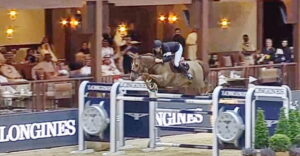
Henrik von Eckermann and King Edward.
It was the second championship for Sweden at the competition, with Patrik Kittel also scoring for his homeland in taking the Dressage World Cup on Friday.
Winning the way Henrik did took a toll, and he understandably was exhausted by the tremendous effort.
“I’m so tired. I’m so empty. It’s like someone pulls the plug out of you. It didn’t help that I fell off in the warm-up,” he noted. The mishap came when King Edward had an uncharacteristic refusal.
“It doesn’t help to get nervous or stressed, because the horse feels everything and King Edward is anyway a very, very sensitive horse, so for him when that happened, I just said, `Don’t worry, let’s stay calm and don’t let him feel that everything is a little not like it should be,’ ” he explained.
“I think I paid the price for my jump-off on Friday,” Henrik observed, saying maybe he “exaggerated a little bit” with the wild gallop he took to the final fence in that tie-breaker to insure victory.
“I was so fed up with being second from the other shows, I did three 5-stars and was second in every one” he explained, noting that was what happened when he played it safe.
But the key to victory at the first Final in the Middle East was the teamwork between horse and rider.
“It went well and we’ve been together so long and know each other so well that I had the biggest confidence in him, and that helped to have that feeling that, even with this mistake, what happened, happened. It was still zero on the scoreboard and that’s what counts! So I just focused on that,” Henrik said.
He joins a short list of back-to-back winners of the Cup, including Britain’s John Whitaker (Milton), Canada’s Ian Millar (Big Ben), Austria’s Hugo Simon (who won the first Cup final in 1979, then went on to do two in a row in 1996 and 1997), Rodrigo Pessoa of Brazil, who won three times in a row; Meredith Michaels Beerbaum of Germany, who won twice in a row in 2008 and 2009, after winning the first time in 2005 and Steve Guerdat of Switerland, who won back-to-back in 2015 and 2016, then won again in 2019.
The field that was lined up against him was filled with formidable names, including France’s Julien Epaillard, known for his ability to ride at speed He was just one rail behind the winner on the mare Dubai du Cedre, and would have been dangerous if it came down to a jump-off.
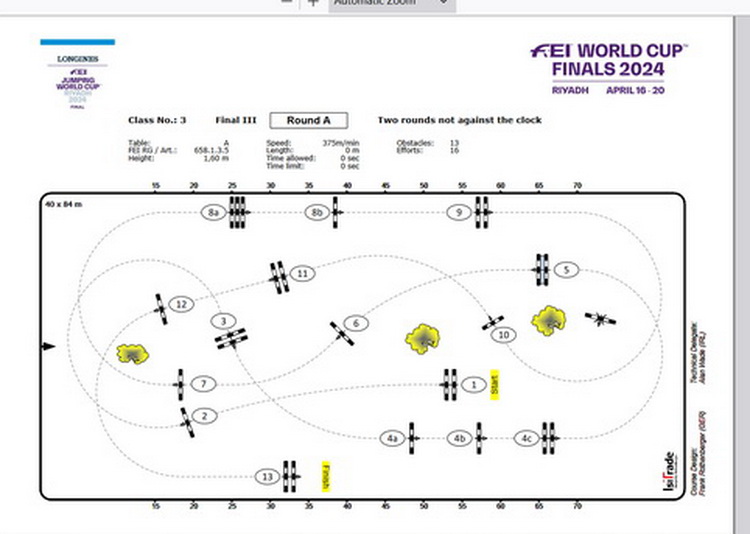
Round A course
Julien said the idea of coming to the World Cup was to “make another championship with her before the Olympics (in Paris this summer) to see what we have to work (on), what at the moment was not 100 percent. Today we have a top feeling and I think the mare and I have a nice program for the Olympics now.”

Julien Epaillard, Henrik von Eckermann and Peder Fredricson on the podium.
Henrik’s teammate, Peder Fredricksen on the 18-year-old Catch Me Not, was just two penalties back of Julien. The USA’s Kent Farrington barely missed the podium on his rising star Greya, only 10 years old and a mere four penalties behind Peder after having a rail in the second round.

Peder Fredricson and Catch Me Not, part of the Swedish power pack. (Photo © 2024 by Melanie Smith Taylor)
“That’s a very impressive finish,” U.S. chef d’equipe Robert Ridland observed, noting Kent has brought his mare along “really carefully.” Robert pointed out the finish really means something because, “The caliber of this competition is very impressive.”
Kent totally agreed.
“Obviously, coming here with my two lesser experienced horses (Toulayna went in the initial speed leg) I knew my chance at winning was going to need everything to go my way. They are short on experience, but havea lot of talent and finished fouorth behind the best horses in the world, I think, was a great finish and both horses will have learned a lot also,” he said.
The U.S. wound up with two riders in the top 20, as Devin Ryan finished seventeenth overall on veteran Eddie Blue, who was second in the 2018 World Cup finals.
“He and Eddie Blue got better every round,” Robert said, noting that if Devin hadn’t had three rails in the first leg on Wednesday “it would have made all the difference.”
Even so, he told me, “Devin had a solid World Cup final.

Saturday’s second course.
Devin, tied for tenth in the final day’s competition, was asked how he thought his horse did. The rider replied, “he felt amazing,” while noting the final round designed by Frank Rothenberger was really big.
He had a rail at the third-to-last jump, saying he believed, “I had enough rhythm, but I got a little close and he really got careful off the front pole and it was a bit of stretch the back pole, and we just tipped it down.”
When I asked Robert what the Cup showed us about the competition the U.S. will be facing in Paris this summer, he replied, “I try to pay no attention to our opponents because we have no control over that.”
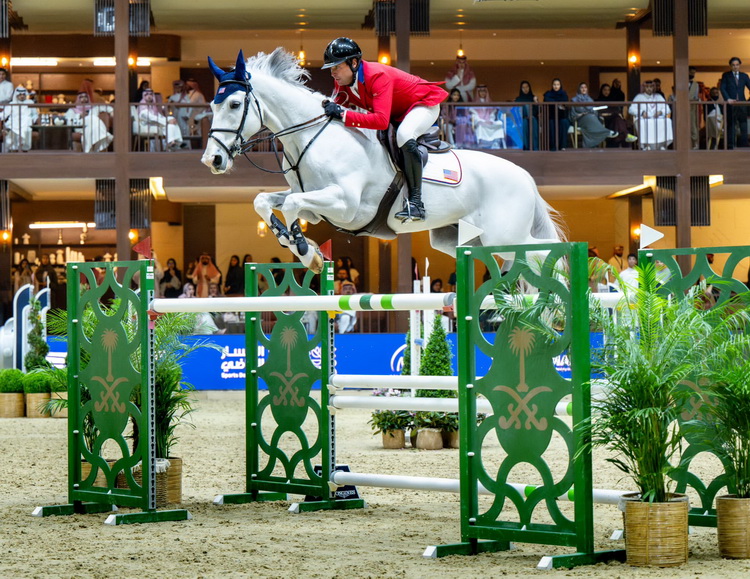
Devin Ryan and Eddie Blue. (Helen Cruden Photography)
Then he went on to say that “the French are strong, there’s no question. The Swedes obviously proved they are consistent and a threat, to say the least. They’ve been strong all the way back to the world championships in Tryon (2018) when we jumped off against them. They just missed winning the world championships by us beating them in the jump-off.
“Then the tables were turned three years later in Tokyo (the 2021 Olympics). And we all know the Irish are strong, too. They didn’t have their strongest riders here. We’ll have some competition, there’s no question about it. I think the level of the sport has never been higher.
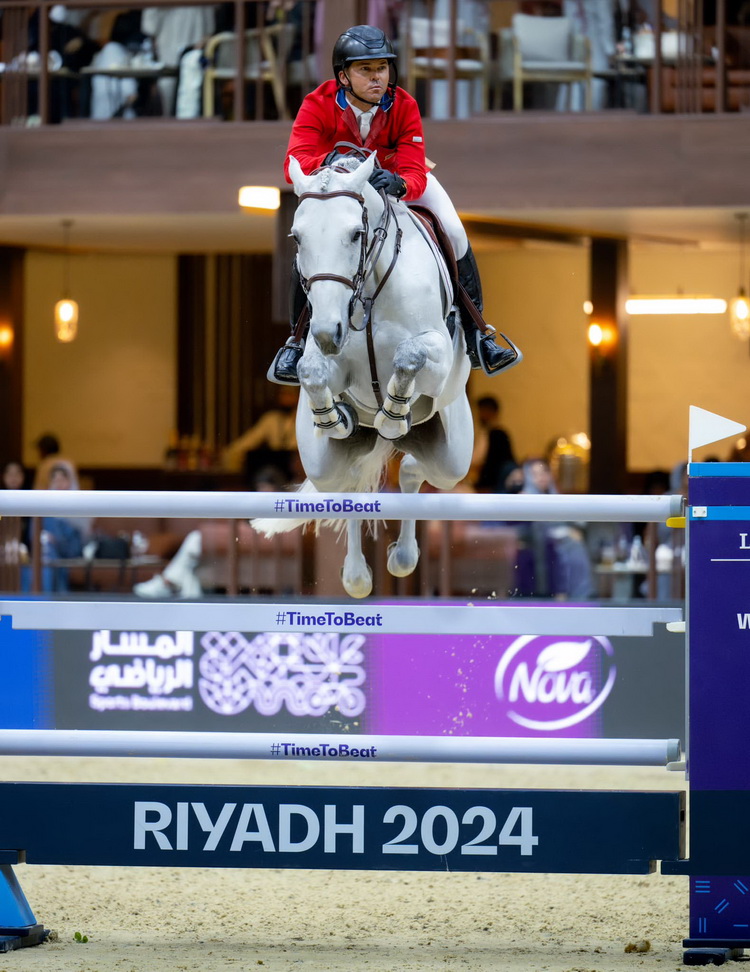
Kent Farrington and Greya. (Helen Cruden Photography)
“You saw all these top riders here, and there were still some missing.”
“With ours, it’s an Olympic year, so it’s not a priority for Laura (Kraut) or McLain (Ward) this close to the Olympics in Paris.”
The show jumping prize money of $2.89 million set a record for the World Cup, which has drawn raves for the way the event had been put on, and Robert was no exception in praising the Saudi effort.
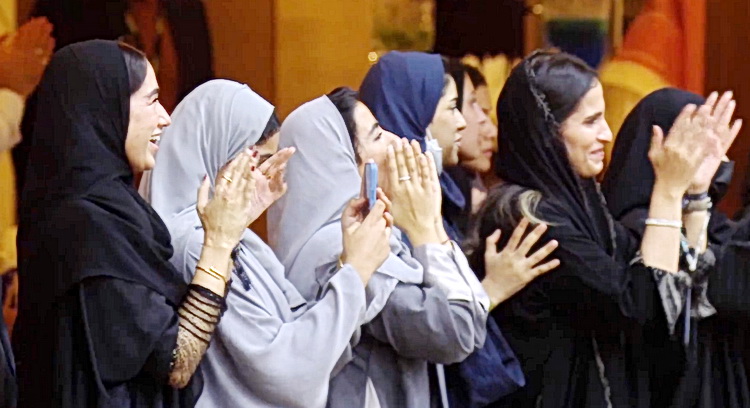
Saudi spectators were very enthusiastic about the competition.
“It was a great World Cup Final from their side. They put a heck of a lot into it. Everything was top notch. No question about how they did it. Everybody friendly, warm-up area was magnificent, the main arena was magnificent; courses obviously, I thought Frank Rothenberger did a good job. The organizing committee went all out. Pretty impressive.”
It can’t go without mentioning the loss of the U.S. mount Chromatic BF after he jumped brilliantly on Thursday.
“It was incredibly sad,” said Robert, noting Jill Humphrey “rode a great round on the horse.” To learn more about what happened, click here.
Click here to see the results of the final competition
Click here to see the final standings
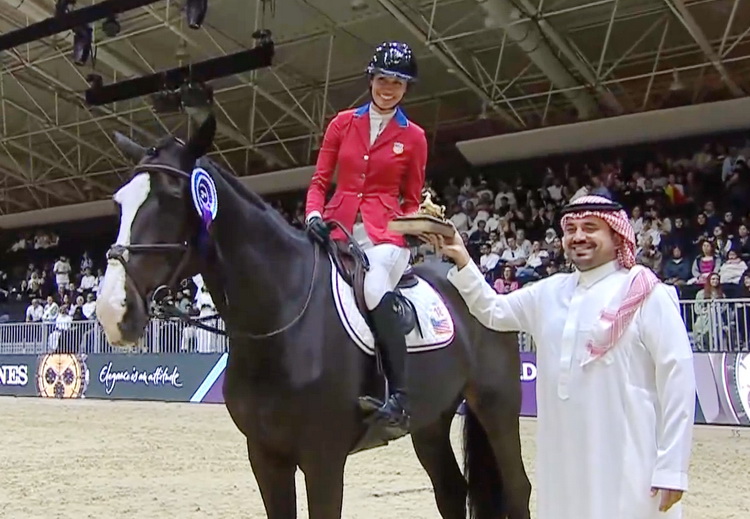
by Nancy Jaffer | Apr 18, 2024
Tragedy followed triumph tonight as Chromatic BF—who earlier had jumped to third place in the Longines FEI Show Jumping World Cup Finals—collapsed in his stall and died in Riyadh, Saudi Arabia. (Click here to read the competition story or go to the second story on this page.)
Ridden by Californian Jill Humphrey, the U.S.-bred Chromatic had shown no symptoms as he returned to the barn after the awards ceremony.
His owner/breeder, Kc Branscomb, explained on social media exactly what happened to the 13-year-old Oldenburg: “I am writing this to try to clarify what has already begun to travel as rumors surrounding events that happened here in Riyadh involving Chromatic after tonight’s spectacular performance. After hacking normally after the class, Chromatic returned to the barn happy and calm attended by his lifetime caretaker, Pepe Rodriguez, and Jill.
“After resting and refreshment, he was given a routine recovery shot of electrolytes by the U.S. team veterinarian. Upon returning to his stable to be wrapped, blanketed, and put away for the evening, with me (KC Branscomb) present, the horse…seizured and collapsed in the stall. He was immediately treated and examined by both the U.S. and FEI veterinarians and was pronounced dead shortly after. As owner and breeder, I want it clearly stated that no one was at fault. The horse did not suffer and there is no evidence that his passing was in any way related to his strenuous and spectacular performance with Jill well over an hour earlier, or the team veterinarian’s injection. A full autopsy report will be provided to me at some point.
“But what I HOPE people will take away from this freak accident and great tragedy is that it was a night of tears — tears of joy and tears of loss. If I would ask anything of those of you that knew or celebrated him, let’s remember him for how he lived and not for how he died. The sport lost a great one today.”
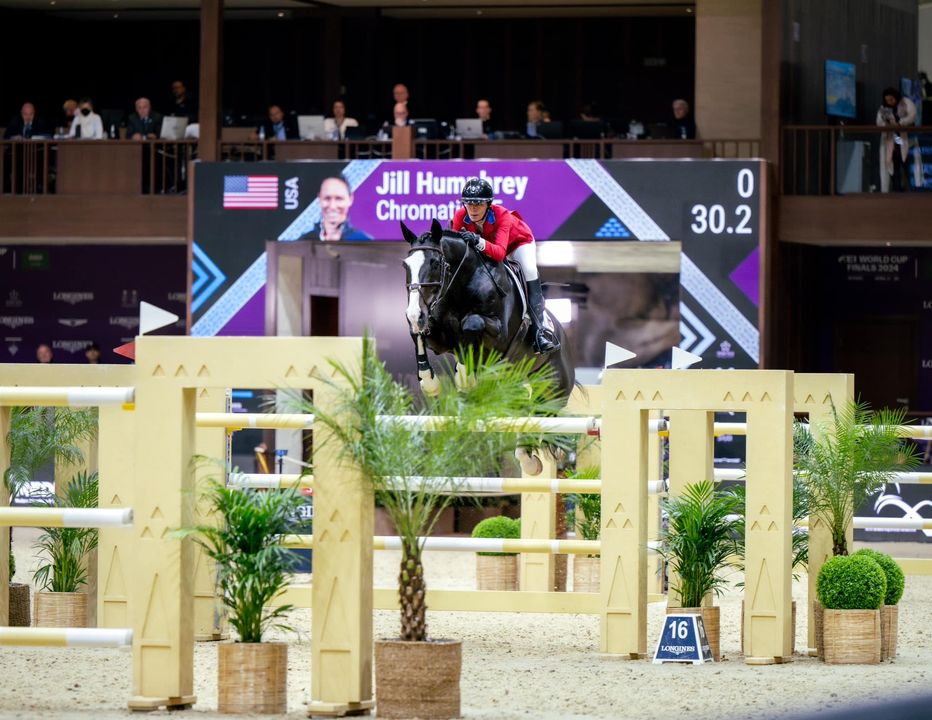
Chromatic and Jill Humphrey competing in the World Cup. (Helen Cruden Photography)
The FEI said samples were already taken from the horse and a full postmortem in line with FEI protocols will be conducted.
“The FEI, the organizing committee and the Saudi Arabian Equestrian Federation send their deepest condolences to the rider, owners, groom and connections.”
People were posting condolences on social media. One of them, John Charlebois, wrote: “He was an amazing horse with a gigantic fan club and a folk hero in the horse world. He was more than a Superstar.”
McLain Ward said that he, his family and his team “send our heartfelt condolences to Kc Branscomb, Jill Humphrey, Rudy Leone and Pepe Rodrigues on the tragic loss tonight of Chromatic. What an incredible story this horse and his people have shared to the top level of the sport.
“I have always thought Jill was a top rate rider and to see the success she’s had, combined with the genuine love for all the positive aspects of our sport and our life with horses from those around Chromatic is inspirational. All of our hearts break tonight with you and know the entire horse world is with you.”
Jan Humphrey Hanson wrote, “My sister has been my riding idol since the beginning of time. There are few that have the natural feel and sheer talent she has. Thank you Chromatic for showing the world this week just how special she is, how special you were, and the unstoppable bond you two formed immediately. I know you’ll put in an impressive double clear round in the sky Saturday night.”
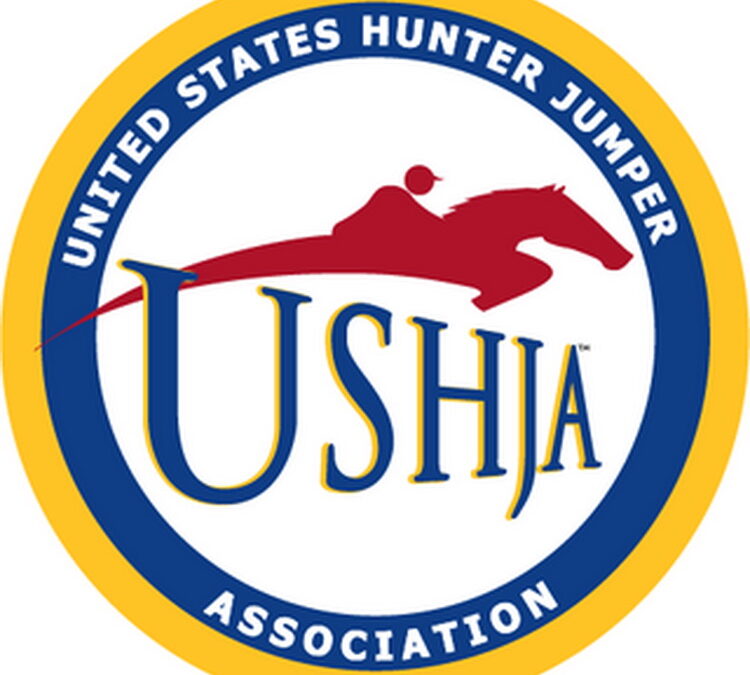
by Nancy Jaffer | Apr 16, 2024
Mary Knowlton, president of the U.S. Hunter Jumper Association since 2016, resigned after an investigation and has been succeeded by Britt McCormick, who was president-elect.
The issue involved building a new, independent information technology system for the Lexington, Ky.-based organization and the matter of oversight on the project.
Knowlton explained, “I was the subject of a whistleblower complaint, which is fine, and I was investigated. After the report came out, I was not afforded the chance to answer questions or speak in my own defense,” she continued, adding, “I find that to be dreadful, cruel and unAmerican.”
She noted that perhaps the USHJA board would have felt the same about her and others mentioned by the whistleblower if they were able to speak to the panel “but we weren’t offered that chance.”
McCormick, who was elected last December but wasn’t scheduled to take office until this December, said the “extensive” examination was undertaken by independent investigators.
The Texan, who took over after Knowlton’s Friday resignation, addressed her contention that she wasn’t given the opportunity to speak to the board in her defense. He explained, “She was interviewed by the independent investigators and made many statements and the board received those statements. I’ll just leave it at that.”
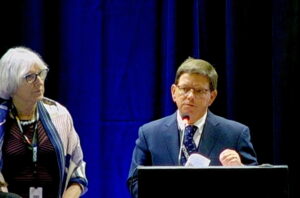
Mary Knowlton and Britt McCormick in 2023.
Noting the project will continue, he commented, “We’re spending members’ money, so we have to be very diligent in how we do that. I’ll be involved in informing the board of every step along the way, every expenditure that we make, any changes to the project. All of that will be brought to the board’s attention in a timely manner.”
In an email she sent to fellow volunteers on Tuesday, Knowlton said the board had given her only two choices; to resign or face “forcible removal.”
She said she chose resignation because she wanted to leave with dignity and that route aligned with the core values she strives to uphold in her personal and professional life. In the email, she emphasized to its recipients, “I remain open to being a resource if you need me.”
Kevin Price, who served as executive director under Knowlton, will continue in that role, McCormick said.
“Kevin has been instrumental in this transition. I will say kudos to the entire USHJA staff because they have been amazing.”
While it’s a time of change in the organization marking its twentieth anniversary, USHJA Vice President David Distler said, “I have faith in Britt. I think Britt’s going to do a great job.”
Asked about goals he wants to pursue immediately, the new president said, “The number one thing is repairing our relationship with the membership and repairing the relationship with the Federation (U.S. Equestrian Federation) and working to become the absolute best affiliate we can be.”
He believes “we lost the faith of some of the membership and we for sure needed a better relationship with the Federation.” USHJA is the largest USEF affiliate organization.
He also mentioned working on sport growth “not only at the introductory levels, but really looking to grow the sport at the elite and upper levels as well. We’re growing by leaps and bounds since Covid and we just need to take a fresh look at what our products are and who our customers are and get feedback from our stakeholders and make sure we’re on the right path.”
McCormick encourages people to get involved, “and make their voice heard, whatever that looks like for them. We would like new, fresh faces and people from all over the country at every level and every interest level. Everybody that jumps a horse, we welcome you in.
The president noted he is an active trainer and competitor “so I’m actually in the field. I think that sets me apart from a lot of people.”
McCormick commented, “I wish Mary nothing but the best and hope she stays a part of our community,” saying, “It’s up to her, her level of involvement.”
He mentioned she’s currently a member of the nominating committee and serves on a couple of other committees.
One thing he would like to change is the yearlong lag between election of a new president and the time that person assumes office. He wants to go back to the old system of a September election and having the winner take over in December.

by Nancy Jaffer | Apr 8, 2024
There have been a number of last-minute horse/rider pairings at Grand Prix this season, the latest being Marcus Orlob and Jane, together only for eight weeks.
Last weekend, they won the 3-star Grand Prix Special with 71.894 percent at TerraNova Equestrian Center outside of Sarasota, Fla. Marcus, based in Annandale, N.J., and Jane are fourteenth in the standings for the three-member U.S. Olympic team that will go to Paris this summer. But first things first, and they will have to hustle even to make the top eight who fly to Europe for competition before final selection is made.
“We’re running out of time,” said Marcus, who is showing at the World Equestrian Center in Ocala this week. He finished second Thursday in the Grand Prix for Freestyle with a mark of 69.913. He was behind Olympic medalist Adrienne Lyle and Lars van de Hoenderheide, who won with 72 percent. Third, one point back of Marcus, was Ecuador’s Julio Mendoza Loor and Jewel’s Goldstrike with 68.913. They have already qualified for Paris by virtue of taking individual gold last fall in the Pan American Games.
On Friday night in the cavernous WEC stadium, the tables were turned, with Goldstrike topping an 11-horse field for the Freestyle on 77.55 percent. Experience counts for a lot when riding to music; Julio’s had a techno flair that his performance matched perfectly. He was particularly pleased with the way his horse handled the transition from the canter pirouette to the piaffe.
“I wanted him to stay with me and be with me during the entire test. He did it, and I am very pleased with that,” Julio said, while thanking his wife, Jessica, for her encouragement and support.
Adrienne was second on Lars, less than a point behind Julio, on 76.145 percent. She rode to music previously used by Wizard, her 2012 Olympic mount. It’s a bright medley that runs from “You’ve Lost That Loving Feeling” to the bouncy “Dancing on the Ceiling” and Lars handled it well despite their lack of time together.
Spain’s Pablo Gomes Molina with Ulises de Ymas finished third on 74.315, while Marcus and Jane’s first freestyle performance had some lovely moments to lush music that offered a serenade of strings. They wound up fourth on a respectable 73.890 percent. (For results of the freestyle, click here)

Marcus and Jane doing their freestyle in the stadium.
Marcus and Jane go to TerraNova again for the last qualifying competition at the beginning of May. They made their Grand Prix debut only at the final Wellington, Fla., show last month, but went from fourteenth in the Grand Prix to fourth in the Special over a two-day period there.
Jane had been shown successfully at Intermediate level by her owner, Alice Tarjan, who has been training the Dutchbred daughter of Desperado since she was three.
Together, they won 11 competitions since 2022, but Jane’s Special score with Marcus at TerraNova was the mare’s best percentage ever.
Jane’s personality changes when she gets in the arena. She becomes much stronger, and Alice was still searching for the way to handle that.
“She knows she has a fantastic horse, but she couldn’t connect with her in the show ring,” said Marcus, who is Alice’s trainer.
After a Grand Prix at White Fences near Wellington, Alice told Marcus, “I think at the moment, it’s too much horse for me.”
So Alice suggested that Marcus “put some mileage on her and get her to settle in the ring.”
He replied, “It’s a fantastic opportunity. I don’t say no to it. But I feel like there’s a lot of pressure on me now. It is a super horse. The quality is not even half there yet; there’s so much more in this horse.”
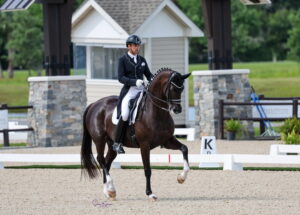
Marcus and Jane at TerraNova. (Photo © by Susan Stickle Photography)
He noted with a chuckle, “Basically, I got pushed right into the water. I wish in general I would have more time. We all know it’s a little bit short notice.”
And now the tables are turned. The student is assisting her trainer.
“I have Alice help me, because she knows the horse inside-out,” said Marcus, explaining she can aid with finding the right tempo and frame for Jane.
In the beginning, he tried to ride more forward to get greater expression in the movements.
“But then, she gets a little too strong and spooky,” Marcus observed.
The next tactic was doing the opposite, trying to “work on relaxation and a little bit more harmony. It seems for now to work better that way.”
He consulted with Christine Traurig, who will be the U.S. chef d’equipe in Paris, and she agreed the way to proceed was, as Marcus recalled her advice, to “go maybe more for a clean test and focus a little bit on the softness and the harmony.”
Once Jane gets in the ring, the power is evident.
“She’s almost like a self-starter,” Marcus observed.
But it “was too much power for Alice. She was basically waterskiing.”
Other new pairings this year, all courtesy of purchases by Zen Elite Equestrian, include Endel Ots with Bohemian and Adrienne not only with Lars, but also Helix. (Read about them at this link.)
But as Marcus pointed out, those horses had loads of international show ring experience and were kept in training by professionals before changing hands. Jane has more of a transition to make. The only Grands Prix she did before Marcus took over were at the National level.

Alice Tarjan and Jane at Dressage at Devon 2022. (Photo © 2022 by Nancy Jaffer)
“That’s the dream, to make the cut (for Europe),” mused Marcus, 42.
Then he wants to “train at home and get to know each other better and focus a little more on expression and each individual movement. But I think at the moment, it’s a little too early. I’m just trying to figure out the changes, pirouettes, the piaffe/passage. She’s a very sensitive mare, which is good, but also very `looky.’ One noise — one person moving from the stands — she looks. So far, it’s quite the journey.”
An advantage he has over the petite Alice is that he is bigger in stature, with longer legs. That means he can use his seat more to get a response from the mare, rather than having to use his hands the way Alice did.
While time is not on his side, progress is being made.
“Each show, I learn something new about her,” he said.
A native of Germany, Marcus came to public attention in 2013 when he rode in the Global Dressage Forum in West Palm Beach, where perennial U.S. team member Steffen Peters (who also grew up in Germany) was working with him.

Steffen Peters and Marcus Orlob at the 2013 clinic in West Palm Beach. (Photo © 2013 by Nancy Jaffer)
“When do you get your U.S. citizenship,” Steffen asked him at the time.
“We really need you.”
Steffen, number two in the 2024 U.S. Olympic rankings, noted back in 2013, “It wouldn’t surprise me if I get to compete with him internationally.”
He may finally have his chance to do that, should Marcus manage to work things out with Jane and achieve his “lofty goal” of finding himself with a ticket to Europe.


































